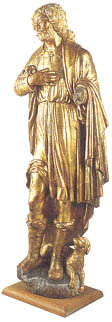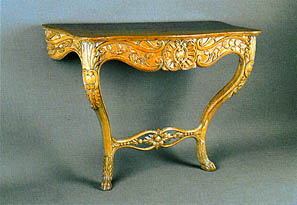 |
The wooden crucifix has been sculpted in Québec ever since Bishop Laval brought a shipload of wood artisans from France to Quebec in 1675. This view shows a wood-sculpted, nineteenth century hearse cruicifix [Royal Ontario Museum, Canadiana gallery] |
From the earliest
settlement of Québec in the seventeenth century, the Roman Catholic
Church was both the official church and an integral part of Québec’s
cultural life.
 |
The wooden crucifix has been sculpted in Québec ever since Bishop Laval brought a shipload of wood artisans from France to Quebec in 1675. This view shows a wood-sculpted, nineteenth century hearse cruicifix [Royal Ontario Museum, Canadiana gallery] |
The Church had always preferred its premises to be both elaborate and ornate. Witness the grand cathedrals and churches of medieval and post-medieval Europe. The rationale, probably the same as that of modern-day law firms or financial houseswanting good and tasteful interior design, was the desire to create an atmosphere of respectability, prosperity, and prestige. The colonial churches, though perhaps not as opulent as those of Europe, were still as ornate as could be achieved by expatriate and native craftsmen. And, since the Church required builders, stonemasons, carpenters, joiners, carvers, sculptors, gilders, glassworkers, and silvermakers, the Roman Catholic church became the greatest single patron and employer of artisans and craftsmen.
In an age when all material goods were individually produced by skilled artisans, craftsmanship flourished. Whole families often pursued the same craft for many generations. Rigid apprenticeship — learning by doing — is a practice going back to the Middle Ages.
Wood sculpture was
a highly specialized and respected craft. In Québec, the Church
was by far the largest, and in some areas, the only employer for wood sculptors
and carvers. By the 1670s, because woodworkers, generally, were in short
supply, Bishop François de Laval brought a shipload of craftsmen
from France in 1675 to teach and train apprentices in New France.
 |
One of the last of the classical Quebec wood sculptors, Louis Jobin (1845-1928), specializing in large religious statues, especially angels, as viewed here, spent a lifetime serving a religious clientele [Royal Ontario Museum, Canadiana Gallery] |
Among the earliest of the woodworkers and sculptors to arrive in New France was Guillaume Jourdain, dit Labrosse (c.1630-90), whose descendants were major figures in the craft for over a century. As well as providing sculpted crucifixes, madonnas, reliquary figures, and decorative carvings, the Labrosse family carved and panelled entire church interiors.
Another seventeenth
century progenitor of a long line of master cabinetmakers and wood sculptors
was Jean le Vasseur (or Levasseur) (1622-86), who arrived in Québec
in 1660 and whose great-grandson Pierre-Noël was still active through
the 1760s. The greatest of the Québec church carvers emerged after
1700. The rococo and baroque style introduced into Franceduring the Louis
XV period emphasized very elaborate and often asymmetrical carving and
because it coincided with the increasing wealth of the church, this style
survived in Québec churches into the 1830s, far longer than in France.
  |
| 1. This life-size, free-standing statue of St. Roch, gilded and sculpted from pine, is typical of the undocumented crafted wood carvings that embellished every church along both sides of the St. Lawrence River in eighteenth and nineteenth century Quebec 2. Attributed to Louis Amable Quévillon (1749-1823), this console table in carved pine can be dated to the last decade of the eighteenth century [Royal Ontario Museum, Canadiana gallery] |
Although cabinetmakers and carvers depended on church commissions, they were also engaged in carving and ornamenting the interiors of private homes as well as crafting individual pieces of furniture.
One of the greatest of the eighteenth century woodworkers was sculptor and architect Jean Baillairgé (1726-1805), who founded a dynasty: his sons François (1759-1852) and Pierre (1761-1812) and his grandson Thomas (1791-1859) continued in the trade. Renowned for churches and church carvings, the Baillairgés are also known for crafting furniture in later English fashions.
Another of the greats was Louis Amable Quévillon (1749-1823). Quévillon, virtually a general contractor, with a large team of cabinet makers and carvers, was responsible for the complete interiors of many well-known churches, and for carved figures including the magnificent altar of Montréal’s église Notre-Dame.
Wood sculpture and many other crafts began slowly to decline by the 1830s. The Québec woodcarvers, as commercial craftsmen, had enjoyed a constant market for their skills as long as they were the only producers. Time was money, however,then as now. Individual craftsmanship was laborious, time-consuming, and expensive. With the coming of new techniques ofmechanized mass-produced wood carving, moulded gesso, and cast decorative plasterwork — all much less expensive — the individual artisan was being forced out of the market.
Although church carving, with its strong, traditional base, continued for decades, it was increasingly restricted to larger free-standing pieces such as madonnas and large crucifixes not easily produced by the newer techniques. During the nineteenthcentury wood carving for church interiors and domestic furniture had all but disappeared.

ABOVE Because of upbeat demand, wood sculpture is still being produced in Québec. St.-Jean Port-Joli, the wood-carving capital of Québec, is located some 60 miles east of Québec City. As many as 60 different wood-carving families, led by Médard Bourgault and brothers, André and Jean-Julien, eked out a living in the 1950s. But the craft, as a whole, has never returned to the high levels achieved by the magnificent carvers of New France whose works still embellish and decorate so many interiors of the early parish churches still standing along the St. Lawrence River. Representing contemporary wood sculpting in Québec is this objet d’art by Benoi Deschênes of St.-Jean Port-Joli. Called Les Voyageurs, it won “Best of the Show” in 1978 at the annual Woodcarving Exhibition sponsored by the Canadian National Exhibition. Carved in basswood and 48 inches long, it demonstrates the interests of modern-day wood carvers in Québec in that the subject matter no longer is restricted to religious iconography but rather reflects the secularization of the contemporary Québecois whose roots extend back to the days of Bishop Laval, Louis XV, even Samuel de Champlain....[Benoi Deschenes]
As sons failed to follow fathers, the surviving carvers gained a greater share of a declining market. Fortunately, the craft itself held on and never really died out. In fact, the last of the great church carvers, Louis Jobin (b. 1845) worked until his death in 1928. Jobin is memorialized at such places as the basilica at Ste.-Anne de Beaupré where a number of his works grace the magnificent interior of this world-famous shrine.
In the mid-1930s Québec experienced a craft revival that continues to the present. The impetus was not the Church or wealthy individual patrons but collectors, a sympathetic tourist market, and a growing international interest. In fact, a few superb studiowood sculptors continue to be active. And although wood carving in Québec has not disappeared, the craft as a whole will never return to the high levels achieved in Québec by the great church carvers of the eighteenth and nineteenth centuries.